The Splendor of the Orion Nebula (Photos)
Orion Nebula by Brian Davis

Brian Davis took this photo of the Orion Nebula from a driveway in the suburbs of Sumter, S.C., over 3.5 hours on Jan. 1, 2012 using a QSI 583wsg camera, Stellarvue SVR105 4" APO Refractor telescope, mounted on a Celestron CGE. Davis sent the image in to SPACE.com on Oct. 8. The entire region of the sword of Orion can be seen in the photo. The Running Man Nebula, or NGC 1977, is visible to the left of the image. [Read the Story Behind This Photo Here]
Orion Nebula NGC 1980
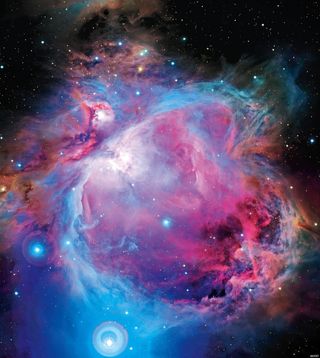
Once thought to be part of the Orion nebula, the star cluster NGC 1980 is actually a separate entity, scientists say. It appears around the brightest star seen at the bottom of this image, iota Ori. The disks around the star are the result of internal light reflection in the camera optics.
Outskirts of the Orion Nebula
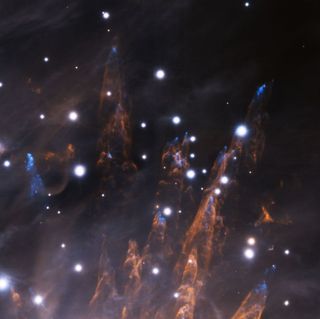
This image, obtained during the late commissioning phase of the GeMS adaptive optics system, with the Gemini South AO Imager (GSAOI) on the night of December 28, 2012, reveals exquisite details in the outskirts of the Orion Nebula.
Detailed Views of the Orion Bullet Region
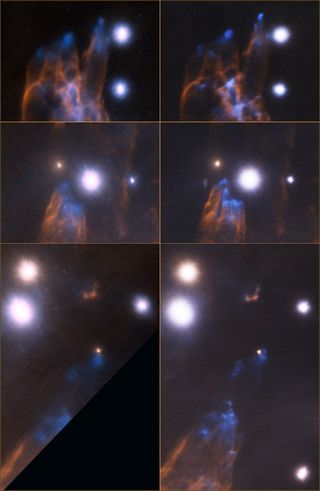
In each image pair, left is the Altair 2007 image and right is the new 2012 GeMS image. This close-up view emphasizes the gain realized by MCAO and GeMS compared to normal AO (Altair).
The Splendor of Orion: A Star Factory Unveiled
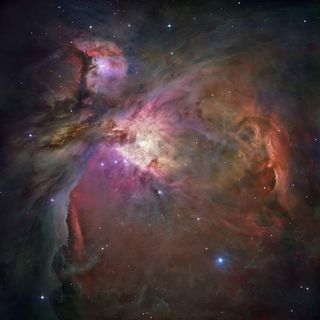
This new Hubble image of the Orion Nebula shows dense pillars of gas and dust that may be the homes of fledgling stars, and hot, young, massive stars that have emerged from their cocoons and are shaping the nebula with powerful ultraviolet light.
SOFIA Image of Orion Nebula
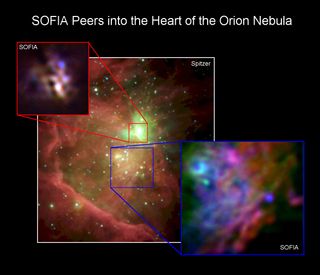
This image compares two infrared pictures of the heart of the Orion nebula captured by the FORCAST camera on the SOFIA airborne observatory's telescope with a wider image of the same area from NASA's Spitzer space telescope.
Cosmic Bullets Pierce Space Cloud
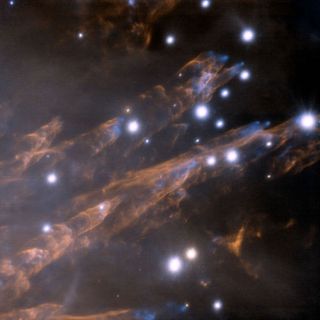
This composite image at infrared wavelengths shows the Orion nebula "bullets" as blue features and represents the light emitted by hot iron gas. The light from the wakes, shown in orange, is from excited hydrogen gas.
Each bullet is about ten times the size of Pluto's orbit around the Sun and travels through the clouds at up to 250 miles (400 kilometers) per second-or about a thousand times faster than the speed of sound.
Get the Space.com Newsletter
Breaking space news, the latest updates on rocket launches, skywatching events and more!
Orion Nebula

This new image of the Orion Nebula was captured using the Wide Field Imager camera on the MPG/ESO 2.2-meter telescope at the La Silla Observatory in Chile.
Famous Orion Nebula Closer Than Thought
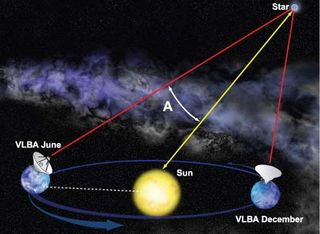
Trigonometric Parallax method determines distance to star by measuring its slight
Twin Stars Born 500,000 Years Apart
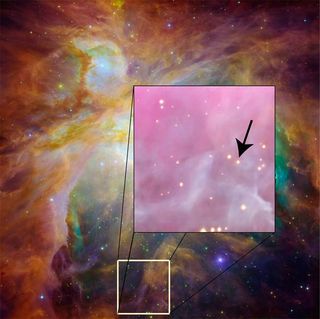
The two identical twin stars (inset) called Par 1802 appear as a single point of light, because they are so close to each other in the Orion Nebula (background).
New Close-up Shows Binary Stars in Orion’s Heart

Left: Zooming into the center of the Orion star-forming region with the four bright Trapezium stars (Theta1 Orionis A-D). The dominant star is Theta1 Orionis C, which was imaged with unprecedented resolution with the VLT interferometer (lower right). Right: The orbit of the binary system (grey line). The size of the orbit of Jupiter around our sun is shown for comparison. Collage: MPIfR (Stefan Kraus), ESO, NASA,HST.
Join our Space Forums to keep talking space on the latest missions, night sky and more! And if you have a news tip, correction or comment, let us know at: community@space.com.

Space.com is the premier source of space exploration, innovation and astronomy news, chronicling (and celebrating) humanity's ongoing expansion across the final frontier. Originally founded in 1999, Space.com is, and always has been, the passion of writers and editors who are space fans and also trained journalists. Our current news team consists of Editor-in-Chief Tariq Malik; Editor Hanneke Weitering, Senior Space Writer Mike Wall; Senior Writer Meghan Bartels; Senior Writer Chelsea Gohd, Senior Writer Tereza Pultarova and Staff Writer Alexander Cox, focusing on e-commerce. Senior Producer Steve Spaleta oversees our space videos, with Diana Whitcroft as our Social Media Editor.
